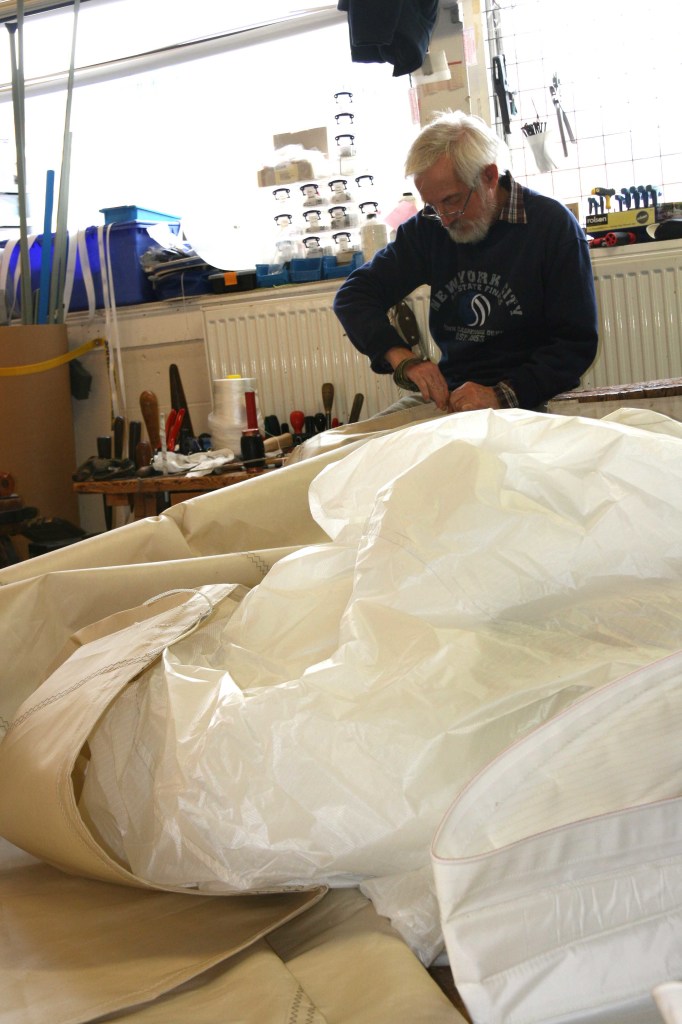 Anyone who has undertaken the restoration of a classic yacht will tell you that the key to success resides in attention to detail. And yet it’s quite strange how often the last things to be considered among the plethora of key decisions are the largest, most prominent and most important parts of any sailing vessel – the sails themselves.
Anyone who has undertaken the restoration of a classic yacht will tell you that the key to success resides in attention to detail. And yet it’s quite strange how often the last things to be considered among the plethora of key decisions are the largest, most prominent and most important parts of any sailing vessel – the sails themselves.
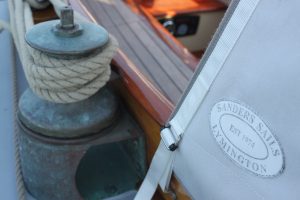 It seems that people will lovingly agonise at length over period interior scrollwork, authentic castings or contemporary rigging components, yet, when it comes to providing the motive force, they’re happy simply to contact the local representative of an international sail manufacturer with a set of measurements and get something perhaps soap powder-white with a modern cut and pressed stainless steel fittings from someone who has never even seen the yacht in question.
It seems that people will lovingly agonise at length over period interior scrollwork, authentic castings or contemporary rigging components, yet, when it comes to providing the motive force, they’re happy simply to contact the local representative of an international sail manufacturer with a set of measurements and get something perhaps soap powder-white with a modern cut and pressed stainless steel fittings from someone who has never even seen the yacht in question.
How many people sailing gloriously restored classic yachts today would guess that a set of ‘classic’ sails, bought from a big name sailmaker might well have been posted directly from a factory in Asia? And how many boat restorers even know the difference between a scraped tail, a tabled edge or a mitred last? One man who knows about all these historic and authentic sailmaking details is Lymington, Hampshire-based sailmaker of forty years standing, Pete Sanders.
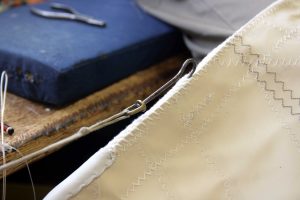 When he started in 1974, Pete Sanders was like most other sail makers in manufacturing everything in his own loft, but now, with the passing of the years, he remains as one of the few major UK-based sailmakers that still manufacture all sails and perform every process for every set of sails, entirely in-house. For the larger outfits, outsourcing has become the key to increasing profits, but product control is essential when producing a special component that should be the crowning glory of any project. And this attention to detail can only be achieved with a carefully ocerseen, personal service. Every stitch, pleat and cut of a Sanders sail is performed under the gaze of Peter himself.
When he started in 1974, Pete Sanders was like most other sail makers in manufacturing everything in his own loft, but now, with the passing of the years, he remains as one of the few major UK-based sailmakers that still manufacture all sails and perform every process for every set of sails, entirely in-house. For the larger outfits, outsourcing has become the key to increasing profits, but product control is essential when producing a special component that should be the crowning glory of any project. And this attention to detail can only be achieved with a carefully ocerseen, personal service. Every stitch, pleat and cut of a Sanders sail is performed under the gaze of Peter himself.
As a company, Sanders is special, as, in its endeavour to tailor precisely every sail it produces to its purpose, the company is as comfortable laser cutting sails for a race winning Farr 40 as it is hand-sewing for a Fife one-off. But if it needs traditional canvas cloth, leather bound corners, mitre cutting or any other period detail, the company has the skills on call, in-house to produce them: to Sanders Sails these things are not extraordinary, it’s just sailmaking. And performance is a given: Sanders sails are the sail of choice among such closely matched fleets as the XODs and the Contessas in the UK, while they have carried owners to countless wins of Round the Islands, Round Britains and National Championships.
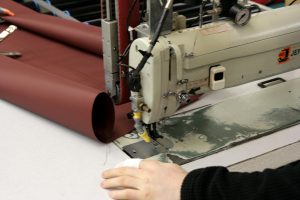 Producing successful classic sails time after time demands at least as much in-depth knowledge as any other aspect of working with classic vessels, and Sanders are able to keep the skills to produce entirely fitting and historically accurate suits of sails by employing craftsmen who have served their apprenticeships at the old-school sailmakers. Will Maddocks is one, and he can produce a scraped tail – where the strengthening cord around the edge of a clew is unlaid and the fibres progressively hand-scraped into a taper before being relaid and stitched in place; or a tabled edge – a complex and historic method of producing a smooth, unpuckered, strengthened edge by inverting and carefully folding and re-stitching the curved off-cut of sail cloth – with his eyes closed, he has done so many. There’s no double-sided tape used here.
Producing successful classic sails time after time demands at least as much in-depth knowledge as any other aspect of working with classic vessels, and Sanders are able to keep the skills to produce entirely fitting and historically accurate suits of sails by employing craftsmen who have served their apprenticeships at the old-school sailmakers. Will Maddocks is one, and he can produce a scraped tail – where the strengthening cord around the edge of a clew is unlaid and the fibres progressively hand-scraped into a taper before being relaid and stitched in place; or a tabled edge – a complex and historic method of producing a smooth, unpuckered, strengthened edge by inverting and carefully folding and re-stitching the curved off-cut of sail cloth – with his eyes closed, he has done so many. There’s no double-sided tape used here.
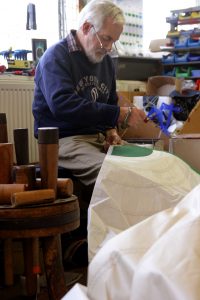 Typically, the construction of a suit of Sanders classic sails would begin with a discussion directly between a yacht owner and Peter Sanders himself. In the initial stages, aspects such as which cloth, cut and level of authenticity would be decided upon. This may include the colour of sails, whether traditional canvas or modern cloth is to be used and what period details are to be incorporated. Peter has an encyclopaedic knowledge of popular yachts past and present, knowing instinctively the requirements for conforming to regulations while getting the best balance of performance over rating, by tailoring the cut and set of the sails. His knowledge also extends into advice on what’s best by way of rigging or hardware for any given situation from racing to cruising – even the sail bag colours are up for grabs in order that everything can be perfectly appropriate. Once the initial discussions are done with, the process then requires a visit to the boat.
Typically, the construction of a suit of Sanders classic sails would begin with a discussion directly between a yacht owner and Peter Sanders himself. In the initial stages, aspects such as which cloth, cut and level of authenticity would be decided upon. This may include the colour of sails, whether traditional canvas or modern cloth is to be used and what period details are to be incorporated. Peter has an encyclopaedic knowledge of popular yachts past and present, knowing instinctively the requirements for conforming to regulations while getting the best balance of performance over rating, by tailoring the cut and set of the sails. His knowledge also extends into advice on what’s best by way of rigging or hardware for any given situation from racing to cruising – even the sail bag colours are up for grabs in order that everything can be perfectly appropriate. Once the initial discussions are done with, the process then requires a visit to the boat.
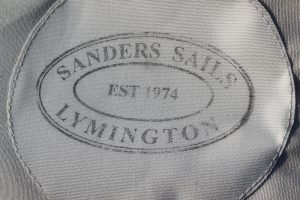 Even though he knows so many yachts inside and out, Peter would not consider beginning to cut even the most straightforward set of sails without seeing the boat in question first-hand and taking the, possibly 100-plus, measurements in person. It seems quite normal today for manufacturers to work from owner-supplied data, but who would be comfortable wearing a three-piece suit made to measure from their own tape-work? Peter believes that by visiting a boat he can not only eradicate the possibility of error and spot any of the plethora of individualities that occur to boats over the years, but it also allows him to visualise exactly what is needed as each sail progresses through his workshop.
Even though he knows so many yachts inside and out, Peter would not consider beginning to cut even the most straightforward set of sails without seeing the boat in question first-hand and taking the, possibly 100-plus, measurements in person. It seems quite normal today for manufacturers to work from owner-supplied data, but who would be comfortable wearing a three-piece suit made to measure from their own tape-work? Peter believes that by visiting a boat he can not only eradicate the possibility of error and spot any of the plethora of individualities that occur to boats over the years, but it also allows him to visualise exactly what is needed as each sail progresses through his workshop.
Technology has, of course, advanced at pace since the days when wooden vessels were the norm, but the key to producing a state of the art sails for classic yachts today is in incorporating those modern advancements while doing justice to each individual vessel, and that can only be done by hand and in-house, with care and craft.
Sanders truly are sails to be proud of.
